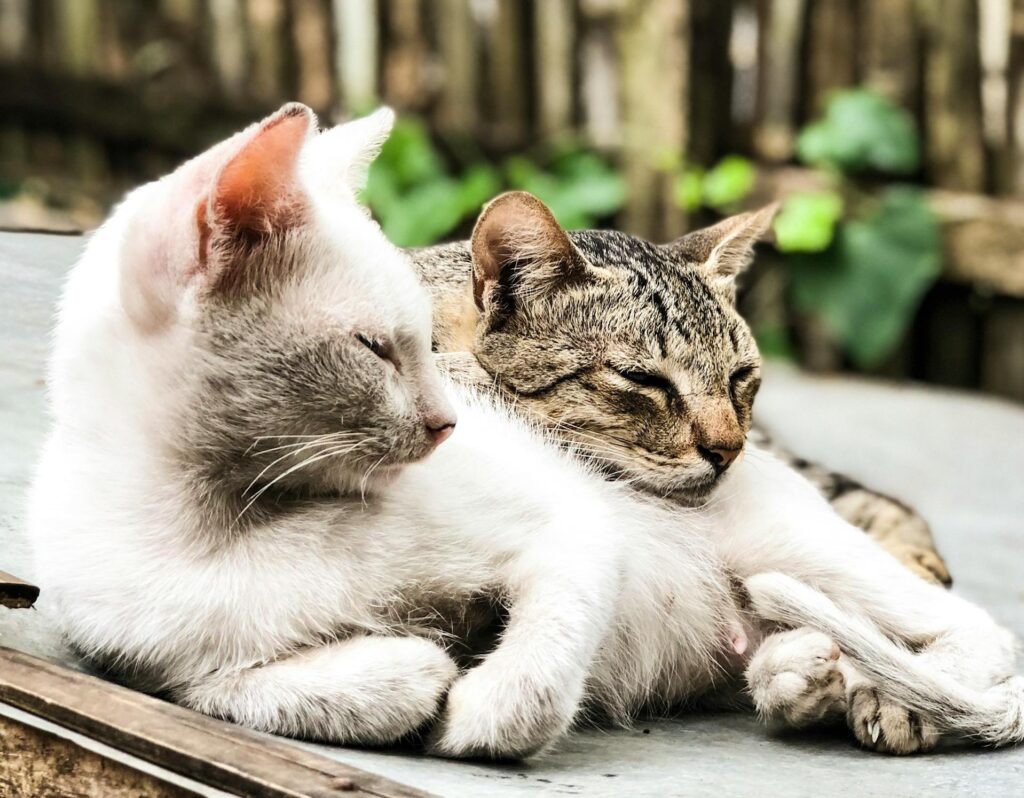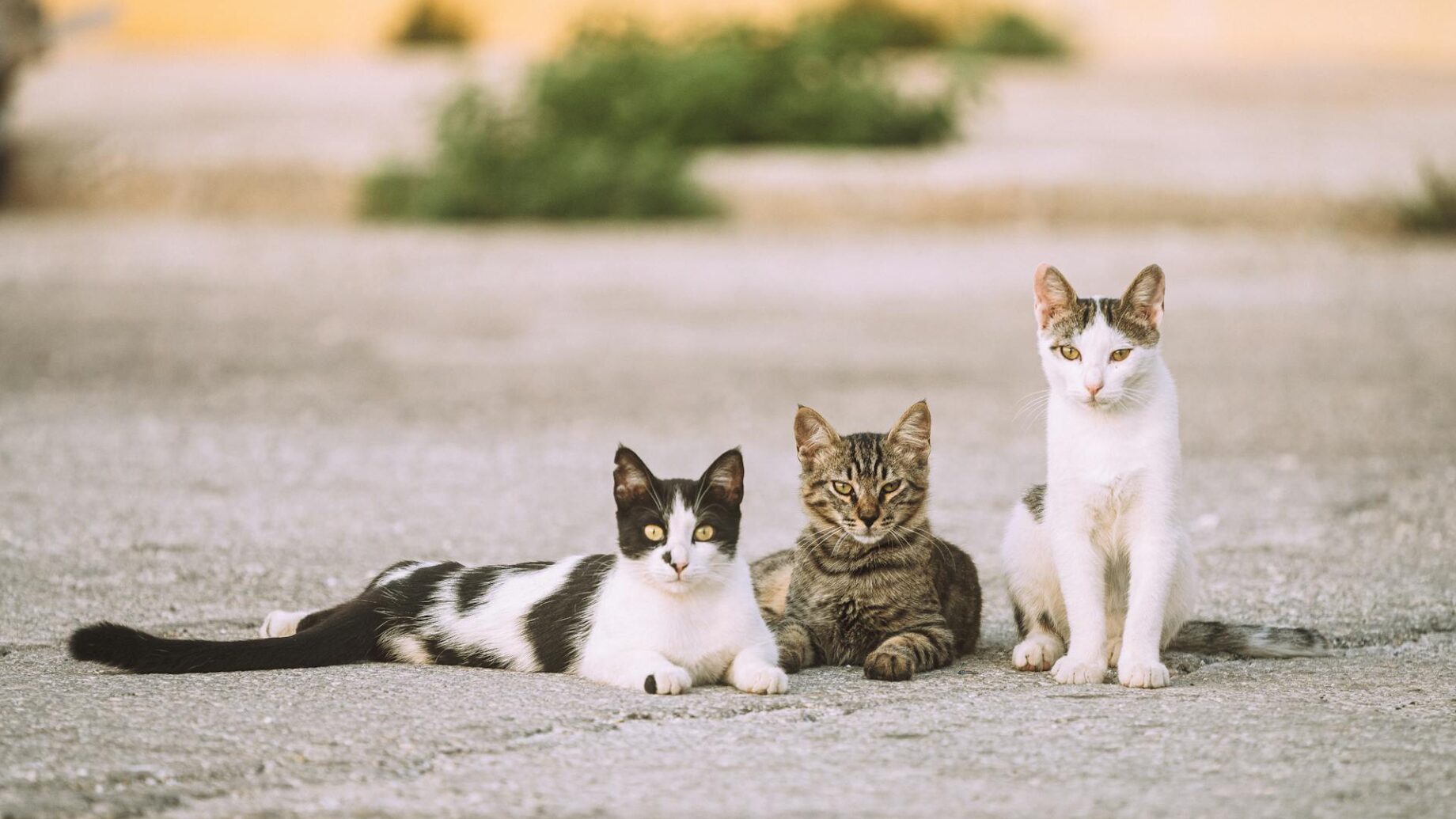Cats are often presented as loners walking their own paths. It is true that their ancestors, North African wildcats, live most of their lives alone, but due to domestication, the social lives of cats are much more interesting.
There are more than 300 million pet cats living in the world. For these cats, humans usually decide with whom they share their home. Sometimes that leads to lifelong friendships, but in other cases the cats may barely tolerate each other and live in constant stress or even resort to fights. But what happens when cats can decide for themselves with whom they share their lives, and how can this knowledge help us provide better lives for our pets?
More food – more cats
Feral cats’ social life is largely dependent on the available resources: food and shelter. If resources are scarce, cats live predominantly alone. Females hold their own territories and defend them against other females. When the kittens are around 5-6 months old the mother will chase them away and they must then find their own territories. Male cats roam larger areas to find females in heat.
If a female’s territory is richer, maybe because there are human resources available, the mother will let her daughters stay with her, forming a small matrilineal colony in which females help each other care for their offspring. They can build a nest together, nurse each other’s kittens and when one cat goes hunting, the rest will defend the young if needed. These benefits of social life seem to counterbalance a serious disadvantage of a common nest – when one cat gets sick, the disease will easily spread to others. Kittens are especially vulnerable; if one becomes ill, all of them may die. Sometimes, a family may accept an unrelated female to their group, especially if she has lived at the edges of their territory for a longer period of time.
Males are usually solitary, but families can also contain one or two tomcats, likely the father(s) of the latest litter. They will help defend the group and their territory. They will chase other males away to monopolise the females, but may also wander off to look for more females to mate with, if they deem it safe.

When there is even more food, for example, near garbage dumps, or where many people actively feed cats, many families may live next to each other in large colonies of up to hundreds of cats. In such colonies, family members will help each other and spend time together, but they only tolerate other families and interact with their members much less. The families compete with each other for territories that are located closer to the food source. When such well-off families grow, tension between members will at some point lead to a split-up, and part of the family must leave the territory to find its own place.
In big colonies, where cats live close to each other, males can no longer monopolise females. They can’t afford to fight with every other male, so they try to mate with as many females as possible. Females usually mate with multiple males, but they prefer the ones they know over strangers.
Communication and maintaining bonds
Life in groups led to the development of a unique signal for friendly intentions – tail up. Kittens, also of related species, use it when approaching their mothers. But only domestic cats use it as adults. One theory is that it evolved in ancient Egypt, where cats were bred in large groups (an unnatural situation for wild cats), and a clear signal of friendly intentions let them avoid unnecessary conflicts.

After greeting with raised tails, cats will often approach each other and rub their heads, flanks and/or tails on each other before going away. Such behaviour can be performed between any two cats of the same group but it’s more often performed between females greeting males or young cats greeting females. Such behaviour may help keep the cohesion of the group by scent exchange and as reaffirmation of trust between animals. Licking each other (allogrooming) also seems to have the same function of maintaining bonds between cats as in the wild, it’s usually performed between related cats.
However, not all cats are friends and as said before, conflicts can emerge. Some signs of conflict are subtle, like staring. Body posture and vocalisations, like hissing, are clearer signals of animosity. They are meant to keep the other cat at a distance, to prevent a physical fight that can have dire consequences, directly and indirectly (e.g. via wound infections). Proper communication is especially important in areas where many cats live together.
Cats learn their social skills from their mother and siblings. This is especially intensive during the developmental stage, from 7 to 14 weeks, but continues in the following weeks as well when the kittens stay with their family. Playing with siblings also develops cognitive, predatory, and motor skills.
When it’s time to be alone
Even though cats can share their lives with each other, there is one domain in which they are strictly solitary – hunting. Even cats that use the same hunting areas rarely do it simultaneously and they don’t collaborate when hunting. Their prey is not big enough to share, so cats prefer to eat alone, even though they may tolerate each other when the food is abundant.
What about our house cats?
In our homes, we decide how long cats stay with their mother, with whom they live and when and where they eat. How can what we learned from the social lives of cats that are free to roam help our pet cats?

In some countries, the age at which kittens can be separated from their mother is too low. Taking a kitten away from its mother and siblings at 8 weeks can lead to disturbances in its sense of security and emotional stability, and disrupt learning processes. This may result in various behavioural disorders and increase the risk of problems in building relationships, both with other cats and with humans. A better age of adoption is 12 or even 16 weeks of age, especially if the kittens are growing up in a good home, when care is taken to prepare them for living with people.
Cats usually show a natural antipathy towards strange cats. Therefore, adopting two kittens from the same litter or a mother and her (female) offspring gives the most chances for a successful long-term relationship. Of course, that option is not always available, and unrelated cats can live in harmony together. However, care should be taken when introducing a new cat to our homes to increase the chances of success. If you are not sure how to do that, seek advice from a behavioural consultant for cats. This way, you can avoid problems in the future. Unfortunately, aggression between cats is one of the most common problems people come to behavioural consultants with. Sometimes conflicts between cats in the same household can be more subtle. They are not always noticed by the owners but still have negative consequences for animal welfare. If your cats are often staring at each other, one cat is blocking access to resources (litter tray, resting place, food or water) for another cat, if one cat leaves the room one the other cat enters, their relationship is not good. Seek professional advice to improve your cats’ lives.
Lastly, don’t feed your cats next to each other. They may tolerate it but will likely prefer to eat at a distance or even in different rooms. Such a small adjustment can have a large positive effect on your cat’s relationship.
This was just a small glimpse into the social lives of cats. Of course, cats’ domestication also had a large effect on the other aspect of their social life: their relationship with us. But that’s a topic for another article.
This text was first published at the Renaissance Garden Guy website.

